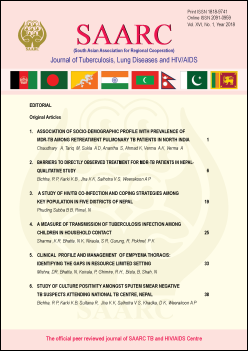Barriers to Directly Observed Treatment for Multi Drug Resistant Tuberculosis Patients in Nepal - Qualitative Study
DOI:
https://doi.org/10.3126/saarctb.v16i1.23239Keywords:
MDR-TB, Barriers, NepalAbstract
Introduction: To prevent the multi drug resistant tuberculosis (MDR-TB) is important to adhere long duration of drug regimen. There are many factors or barriers that are likely to affect adherence to the long treatment regimen.
Objectives: To find out the barriers for adherence to MDR –TB treatment.
Methods: The study was conducted as an institutional based qualitative study, using a convenient sampling technique. Data was collected from 50 current MDR-TB patients by trained field health workers using semi structured interviewer administered questionnaire in all regions in Nepal. Twenty five focus group discussions (FGD) were also conducted with MDR-TB patients, cured MDR-TB patients, DOTS Committee Members, health workers and close relatives of MDR-TB patients to supplement the findings.
Results: Out of 50 respondents 19 were females and 31 were males. Their age varied from 22 years to 61 years. Majority of patients had a previous history of irregular TB treatment. Forty out of fifty patients (80%) were living in either rented houses or hostels (in Mid Western Region). Knowledge about TB and MDR-TB was satisfactory in majority of participants in both studies. Majority of participants were satisfied with facilities and services provided by MDR-TB clinics. There is a very little stigma associated with MDR-TB in Nepal. FGD revealed the onset of MDR-TB was attributed to causes such as smoking, alcohol abuse, poor nutrition, and contact with TB patients. Lack of money to go to health facility daily for treatment was reported as major barriers to adhere to MDR-TB treatment.
Conclusion: Financial constraints were the major barrier for these patients. To sustain proper MDRTB programme, Government of Nepal and other organization should provide social support to these patients.
Downloads
Downloads
Published
How to Cite
Issue
Section
License
Copyright © SAARC Tuberculosis and HIV/AIDS Centre (STAC), all rights reserved, no part of this publication may be reproduced, stored in a retrieval system or transmitted in any form or by any means without prior permission of the STAC.





